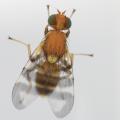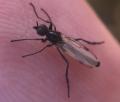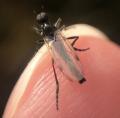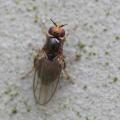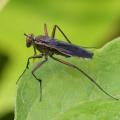Diptera.info :: Identification queries :: Diptera (adults)
Who is here? 1 guest(s)
|
Phryxe ?
|
|
| Cor Zonneveld |
Posted on 01-04-2009 18:47
|
|
Member Location: Amstelveen, the Netherlands Posts: 840 Joined: 14.10.06 |
Today in Amstelveen, Holland. ca 7 mm. On willow with flowering catkins, unsed grass land. Comparing with last year's photos, the best match is Phryxe. Is species ID possible with this photo? Cor Zonneveld attached the following image:  [93.04Kb] Thanks for your attention Cor Zonneveld |
| Cor Zonneveld |
Posted on 01-04-2009 18:54
|
|
Member Location: Amstelveen, the Netherlands Posts: 840 Joined: 14.10.06 |
same specimen
Cor Zonneveld attached the following image:  [112.54Kb] Thanks for your attention Cor Zonneveld |
| Zeegers |
Posted on 01-04-2009 18:55
|
|
Member Location: Soest, NL Posts: 18542 Joined: 21.07.04 |
Looks like Cyzenis albicans to me Theo |
|
|
|
| Cor Zonneveld |
Posted on 01-04-2009 20:23
|
|
Member Location: Amstelveen, the Netherlands Posts: 840 Joined: 14.10.06 |
hm, 'looks like', is that sure enough? Just for me to learn a bit: what makes it different from Phryxe? They al look rather similar to me.... M1 bends differently? In Phryxe just above 90 degrees, here wider angle? Edited by Cor Zonneveld on 01-04-2009 20:25 Thanks for your attention Cor Zonneveld |
| Zeegers |
Posted on 02-04-2009 15:10
|
|
Member Location: Soest, NL Posts: 18542 Joined: 21.07.04 |
Ok, in this case, it is Cyzenis albicans No apparent apical scutallars, bend in vein M close to wing margin, completely dark scutellum (tip always reddish in Phryxe) and foremost: one proclinate orbital seta in both sexes on the parafrontalia (visible in pic 1, if you know what to look for). Head profile (lateral view) is very different from Phryxe, however, invisible in these pics. Theo |
|
|
|
| Cor Zonneveld |
Posted on 08-04-2009 18:54
|
|
Member Location: Amstelveen, the Netherlands Posts: 840 Joined: 14.10.06 |
OK, thanks. Strong language! But then, I asked for it... What subfmily does Cyzenis belong too? For some reason, Fauna Europea cannot be reached for over a week now. ANother question: if I look at the Dutch species list, genera within Tachinidae are VERY small. Compare with the bee genus Andrena: 70 species in Holland alone!! Are all Tachinids that diferent, or is there a tenency among Tachinid describers to assign the status of genus very rapidly? Thanks for your attention Cor Zonneveld |
| romunov |
Posted on 08-04-2009 19:12
|
|
Member Location: Ljubljana, Slovenia Posts: 52 Joined: 13.02.09 |
According to http://itis.gov, it's a tachinid. |
| Cor Zonneveld |
Posted on 08-04-2009 19:50
|
|
Member Location: Amstelveen, the Netherlands Posts: 840 Joined: 14.10.06 |
I know it's Tachinid, but what subfamily?
Thanks for your attention Cor Zonneveld |
| neprisikiski |
Posted on 08-04-2009 20:01
|
|
Member Location: Lithuania Posts: 876 Joined: 23.02.09 |
Exoristinae, Goniini
Erikas |
|
|
|
| Cor Zonneveld |
Posted on 08-04-2009 21:09
|
|
Member Location: Amstelveen, the Netherlands Posts: 840 Joined: 14.10.06 |
Thanks!
Thanks for your attention Cor Zonneveld |
| Zeegers |
Posted on 09-04-2009 20:43
|
|
Member Location: Soest, NL Posts: 18542 Joined: 21.07.04 |
As for the other question, very good question, I don't know. One might add up Cyzenis and Bothria into one genus. However, that still makes a genus of only 4 species. Add Phryno, you have 5. Of course, Andrena is an extreme example. NOntheless.... Theo |
|
|
|
| ChrisR |
Posted on 09-04-2009 23:18
|
|
Administrator Location: Reading, England Posts: 7699 Joined: 12.07.04 |
It might be a defeatist view and I'm fully prepared to admit there's a lot I don't know about tachinids (until recently my knowledge was limited to the commoner UK species) but ... I think we just don't fully understand how the genera are related to each other. There are some morphological similarities that tend to draw together certain genera but they don't amount to much and so there has been a tendency to split them into very small tribes/genera. Features such as the subscutellum appear to be stable across the family but then there are the ones that don't have a subscutellum (Litophasia) ... or rhinophorids that have a partial... it's hard to find 'hard and fast' rules about something as clear as that - so it's not surprising that the genera seem illogical sometimes.  One example that comes to mind - the hairiness of eyes is usually a fairly stable character across a genus and Exorista sp. usually have bare eyes ... except E.grandis  It's hardly a reason for despair though ... it just means that there are lots of exciting things to discover about them! 
Edited by ChrisR on 09-04-2009 23:40 Manager of the UK Species Inventory in the Angela Marmont Centre for UK Biodiversity at the Natural History Museum, London. |
| Zeegers |
Posted on 10-04-2009 08:53
|
|
Member Location: Soest, NL Posts: 18542 Joined: 21.07.04 |
As Monty Wood has pointed out: We lean on bristle position a lot. However, there is only a finite number of positions of bristles feasible, given the maximum numbers on a Tachinid. There are many more species and even genera. So you are bound to find 'parallel evolutions'(homoplasy) only by the argument of statistics. Theo |
|
|
|
| Cor Zonneveld |
Posted on 11-04-2009 13:12
|
|
Member Location: Amstelveen, the Netherlands Posts: 840 Joined: 14.10.06 |
Thanks for the interesting thoughts! I might add a few of myself. I'm very new in flies - my 'stronghold' is European butterflies. Here I have seen fashion-like tendencies in taxonomy. To a large degree, what makes up a genus is arbitrary. When I started with looking at butterflies, the situation was rather as in Tachinidae nowadays: many many small genera, one or two species per genus being quite typical. To date, there is a double tendency. First, to make bigger genera (applaus!), but secondly, to split up species into 'speciescomplexes' whenever that option exists. The tendency to reunite is if not inspired by certainly boosted by DNA research - to a degree that sometimes makes rather counterintuitive genera. DNA is no panacea; but might it help in Tachinids, to get one more handle for classification?! If I understand the argument correctly, so little is known about phylogenetic relationships, that small genera are created to be on the safe side - no suggestion of relatedness unless there is strong evidence. The drawback is that the genus as overarching category looses much of its appeal. Edited by Cor Zonneveld on 11-04-2009 13:19 Thanks for your attention Cor Zonneveld |
| Jump to Forum: |




